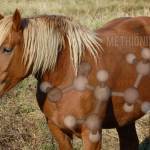Amino Acid Levels Differ in Horses With and Without EMS, Laminitis

The leading cause of laminitis in horses is hyperinsulinemia-associated disease, which occurs in horses with elevated insulin levels. This primarily includes horses with equine metabolic syndrome (EMS). The effects of insulin on glucose metabolism are widely known, but insulin also affects protein metabolism.
Published studies show that horses with EMS have altered blood levels of amino acids, the building blocks of proteins. Elevated insulin levels result in increased utilization of amino acids, which can contribute to elevated amino acid and protein turnover. Thus, the development or progression of laminitis can be affected by altered amino acid levels.
To improve the understanding of amino acid utilization, horses without EMS, with EMS, and with EMS and laminitis were studied.* All horses and ponies were mature and referred to an equine hospital in Berlin, Germany, for evaluation of EMS. All were apparently healthy, except for those that were obese, and all were sound at the walk at time of admittance.
In total, 27 horses suspected of having EMS were included in the study, and all were obese except two. Dynamic testing for EMS was performed using the combined glucose-insulin test (CGIT), which involved collecting a basal (resting) blood sample before administering both glucose and insulin intravenously. Blood samples were collected at predetermined time points every 5 to 15 minutes for 150 minutes. Horses were considered insulin dysregulated, and therefore diagnosed with EMS, if glucose or insulin levels did not return to baseline levels within 45 minutes of the test beginning.
Concentrations of 40 different amino acids were also measured at baseline, and radiographs of the horses’ feet were obtained to determine if they had signs of laminitis.
“Of the 27 horses suspected of having EMS and tested using the CGIT, 14 were insulin dysregulated and diagnosed with EMS, five horses did not have EMS and were just obese, and an additional eight horses had EMS and also laminitis,” explained Ashley Fowler, Ph.D., a nutritionist for Kentucky Equine Research.
Of the 40 measured amino acids, only three were significantly different between the three groups of horses:
- Citrulline was significantly lower in the horses with insulin dysregulation and laminitis than in horses that were obese but did not have insulin dysregulation;
- Gamma-aminobutyric acid (GABA) concentrations were significantly higher in obese horses without insulin dysregulation as well as horses with insulin dysregulation without laminitis compared to the horses with insulin dysregulation and laminitis; and
- Methionine was significantly higher in obese horses without EMS compared to those with EMS and laminitis.
Of those three amino acids, only methionine is used to produce proteins. Citrulline is used for nitrogen recycling in the urea cycle, and GABA is an inhibitory neurotransmitter.
“The clinical relevance of these findings remains to be determined, but this study may help guide future research to determine if horses at risk of developing laminitis would benefit from targeted amino acid supplementation,” Fowler said.
Currently, dietary supplements used in horses with EMS include ration balancers, as many of these horses are on weight-loss programs in which hay is steamed or soaked.
“Soaking hay also reduces concentrations of other soluble nutrients, so providing a ration balancer or vitamin-mineral supplement is important to ensure your horse’s needs are met,” advised Fowler.
*Stoeckle, S.D., D. Timmermann, R. Merle, and H. Gehlen. 2022. Plasma amino acid concentration in obese horses with/without insulin dysregulation and laminitis. Animals (Basel) 12(24):3580.








